Serving 383 students in grades Prekindergarten-5, Indian Hollow Elementary School ranks in the bottom 50% of all schools in Virginia for overall test scores (math proficiency is bottom 50%, and reading proficiency is bottom 50%).
The percentage of students achieving proficiency in math is 35-39% (which is lower than the Virginia state average of 54%). The percentage of students achieving proficiency in reading/language arts is 50-54% (which is lower than the Virginia state average of 69%).
The student:teacher ratio of 15:1 is higher than the Virginia state level of 14:1.
Minority enrollment is 20% of the student body (majority Hispanic), which is lower than the Virginia state average of 56% (majority Black).
Quick Stats (2025)
- Grades: Prekindergarten-5
- Enrollment: 383 students
- Student:Teacher Ratio: 15:1
- Minority Enrollment: 20%
- Overall Testing Rank: Bottom 50% in VA
- Math Proficiency: 35-39% (Btm 50%)
- Reading Proficiency: 50-54% (Btm 50%)
- Science Proficiency: 30-39% (Btm 50%)
- Source: National Center for Education Statistics (NCES), VA Dept. of Education
School Overview
Indian Hollow Elementary School's student population of 383 students has declined by 9% over five school years.
The teacher population of 26 teachers has stayed relatively flat over five school years.
Grades Offered
Grades Prekindergarten-5
(offers virtual instruction)
(offers virtual instruction)
Total Students
383 students

Gender %
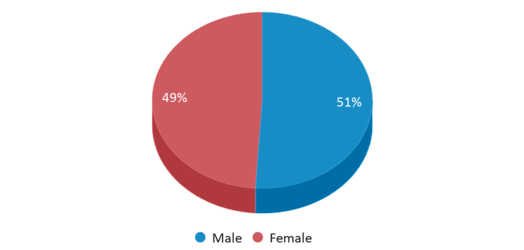
Total Classroom Teachers
26 teachers
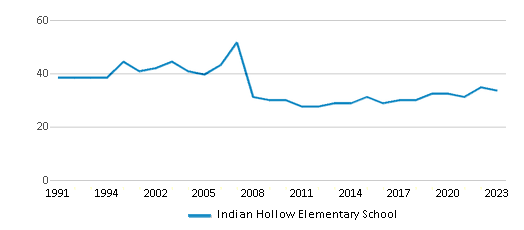
Students by Grade
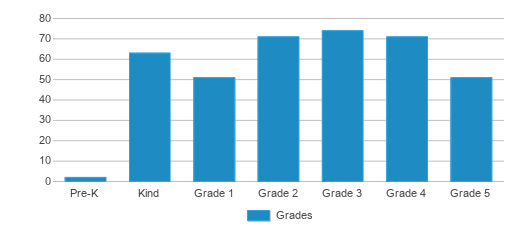
School Rankings
Indian Hollow Elementary School ranks within the bottom 50% of all 1,792 schools in Virginia (based off of combined math and reading proficiency testing data).
The diversity score of Indian Hollow Elementary School is 0.35, which is less than the diversity score at state average of 0.72. The school's diversity has stayed relatively flat over five school years.
Overall Testing Rank
#1448 out of 1792 schools
(Bottom 50%)
(Bottom 50%)

Math Test Scores (% Proficient)
(20-21)35-39%
54%
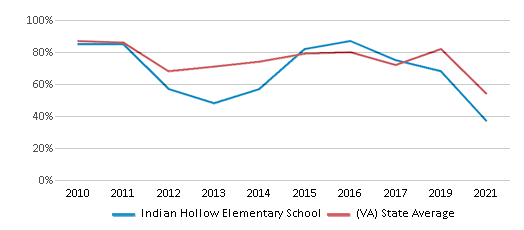
Reading/Language Arts Test Scores (% Proficient)
(20-21)50-54%
69%
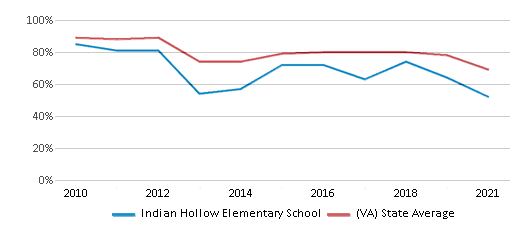
Science Test Scores (% Proficient)
(20-21)30-39%
59%
Student : Teacher Ratio
15:1
14:1
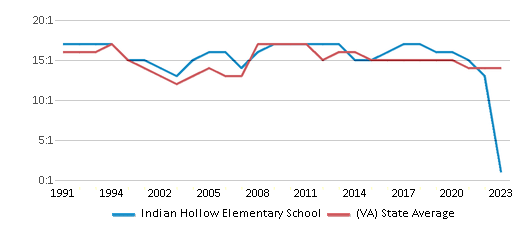
American Indian
n/a
n/a
Asian
1%
8%
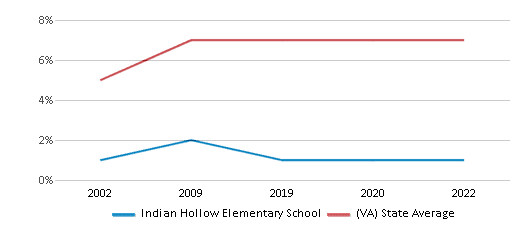
Hispanic
11%
19%
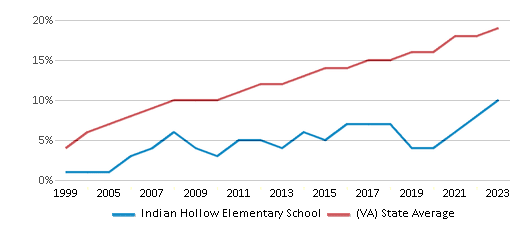
Black
2%
22%
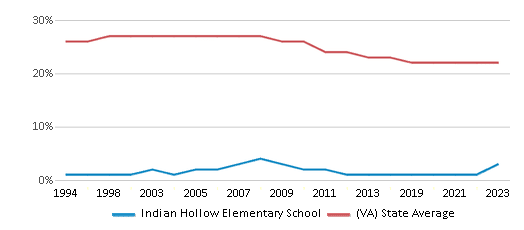
White
80%
44%
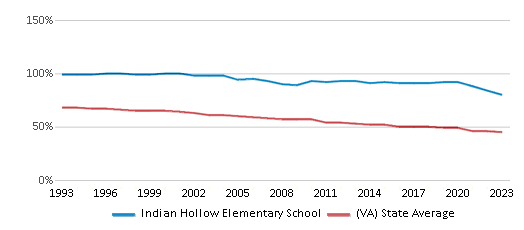
Hawaiian
n/a
n/a
Two or more races
6%
7%
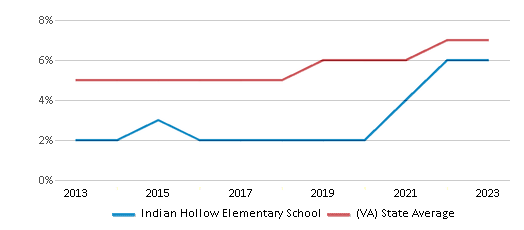
All Ethnic Groups

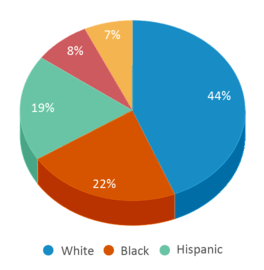
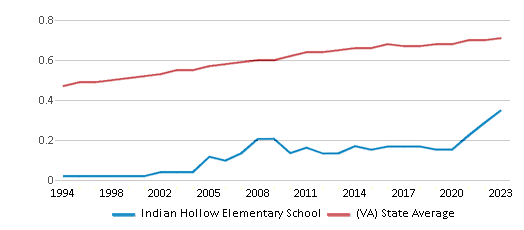
Eligible for Free Lunch
70%
55%
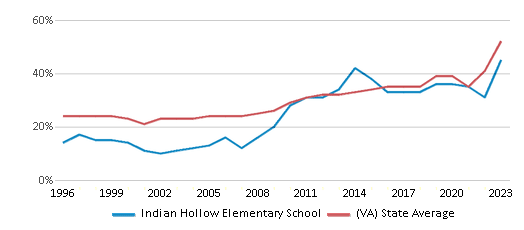
Eligible for Reduced Lunch
5%
2%
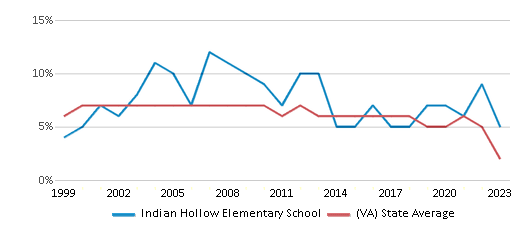
School Statewide Testing
School District Name
Source: National Center for Education Statistics (NCES), VA Dept. of Education
Profile last updated: 02/09/2025
Frequently Asked Questions
What is Indian Hollow Elementary School's ranking?
Indian Hollow Elementary School is ranked #1448 out of 1,792 schools, which ranks it among the bottom 50% of public schools in Virginia.
What schools are Indian Hollow Elementary School often compared to?
Indian Hollow Elementary Schoolis often viewed alongside schools like Bass-hoover Elementary School, Greenwood Mill Elementary School by visitors of our site.
What percent of students have achieved state testing proficiency in math and reading?
35-39% of students have achieved math proficiency (compared to the 54% VA state average), while 50-54% of students have achieved reading proficiency (compared to the 69% VA state average).
How many students attend Indian Hollow Elementary School?
383 students attend Indian Hollow Elementary School.
What is the racial composition of the student body?
80% of Indian Hollow Elementary School students are White, 11% of students are Hispanic, 6% of students are Two or more races, 2% of students are Black, and 1% of students are Asian.
What is the student:teacher ratio of Indian Hollow Elementary School?
Indian Hollow Elementary School has a student ration of 15:1, which is higher than the Virginia state average of 14:1.
What grades does Indian Hollow Elementary School offer ?
Indian Hollow Elementary School offers enrollment in grades Prekindergarten-5 (offers virtual instruction).
What school district is Indian Hollow Elementary School part of?
Indian Hollow Elementary School is part of Frederick County School District.
School Reviews
2 4/9/2015
My son started Kindergarten this 2014-2015 school year..very quick to pick out the negative stuff,not so much on the positive.. my son scored an 86 out of 102 best, in the fall, at the beginning of the school year. yet every report card says he doesn't pay attention,follow directions,or work well independently. He can read at his level,he knows and demonstrates every lesson he has learned in school and is a whiz at math. Unfortunately,I have to keep him there and can't afford private school right now. Also,if your kid does something small that's wrong,they use you as an example and destroy your kid's confidence and social skills.. My son HATES this school so much,that he cries when he comes home..I was warned not to send him..I really wish I hadn't.. Sincerely, the unsilent majority.
Review Indian Hollow Elementary School. Reviews should be a few sentences in length. Please include any comments on:
- Quality of academic programs, teachers, and facilities
- Availability of music, art, sports and other extracurricular activities
Recent Articles

What Is A Charter School?
Explore the world of charter schools in this comprehensive guide. Learn about their history, how they operate, and the pros and cons of this educational innovation. Discover key facts about charter schools, including admission policies, demographics, and funding, as well as what to look for when considering a charter school for your child.

10 Reasons Why High School Sports Benefit Students
Discover the 10 compelling reasons why high school sports are beneficial for students. This comprehensive article explores how athletics enhance academic performance, foster personal growth, and develop crucial life skills. From improved fitness and time management to leadership development and community representation, learn why participating in high school sports can be a game-changer for students' overall success and well-being.

February 05, 2025
Understanding the U.S. Department of Education: Structure, Impact, and EvolutionWe explore how the Department of Education shapes American education, from its cabinet-level leadership to its impact on millions of students, written for general audiences seeking clarity on this vital institution.





